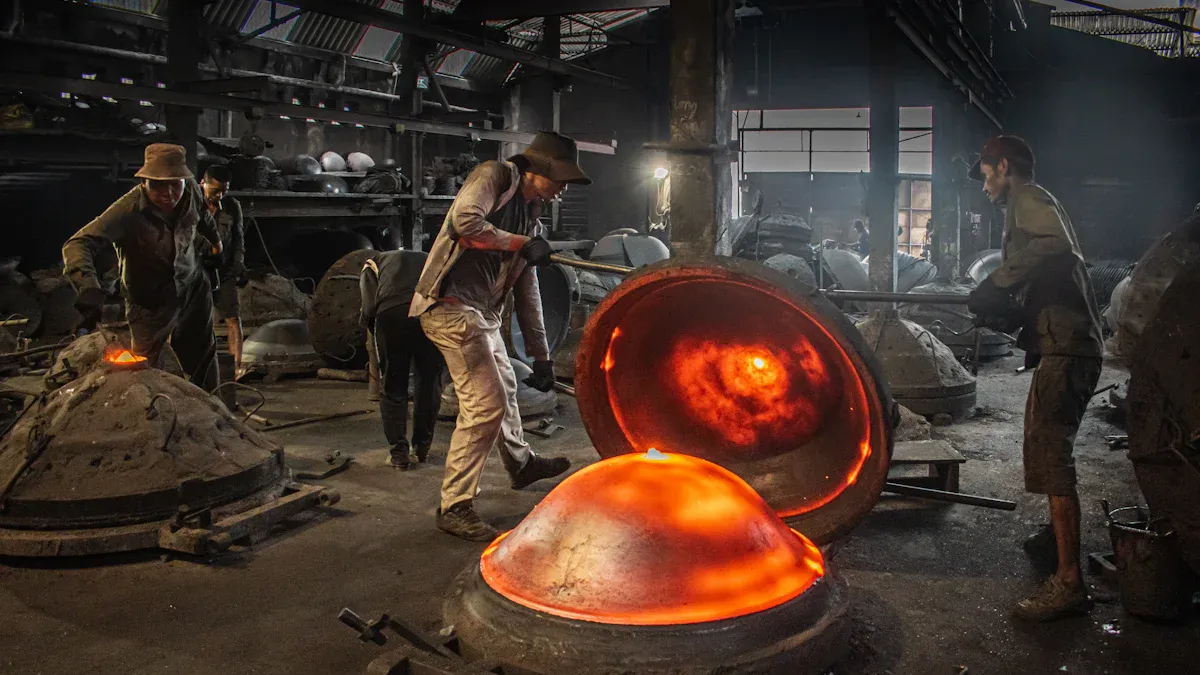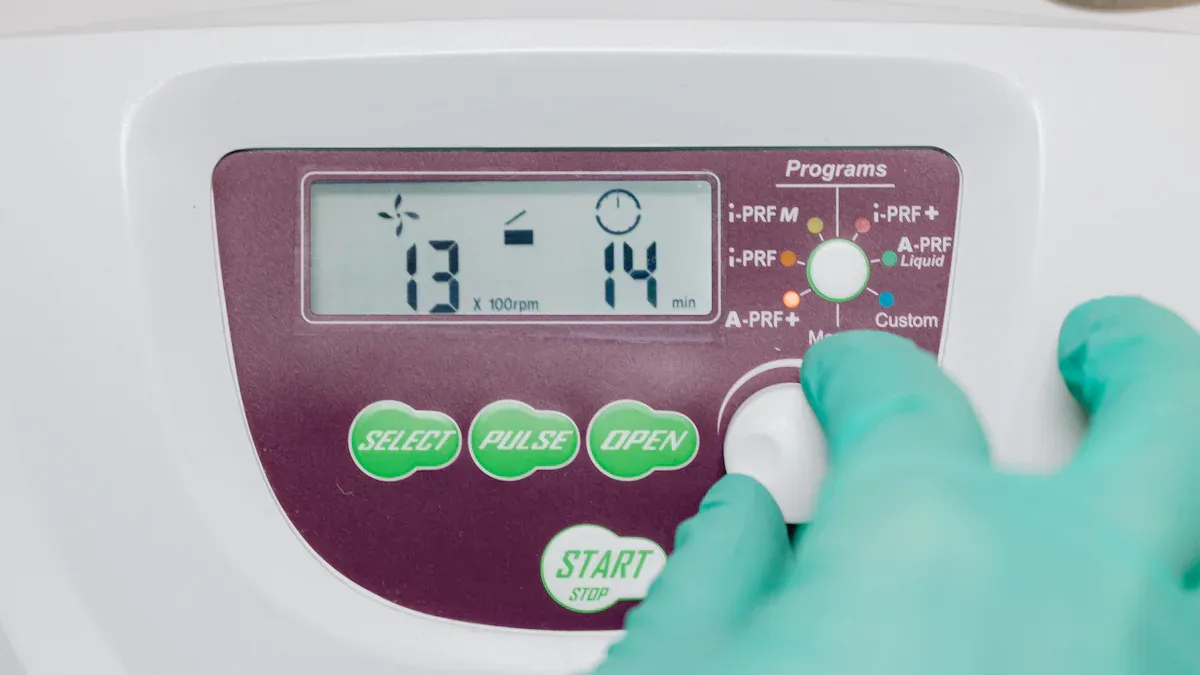
The Metal Die Casting process is a manufacturing technique where molten metal is injected into a mold under high pressure. This method creates precise, durable components, making it ideal for centrifuge manufacturing. You might wonder how this process becomes even more efficient for centrifuges. The answer lies in centrifugal force. By spinning the mold rapidly, the force evenly distributes the molten metal, ensuring uniformity and strength. This approach is also common in industries like automotive die casting, where precision and durability are essential. For centrifuge parts, aluminum pressure die casting often provides the perfect balance of lightweight and resilience.
Key Takeaways
- Metal Die Casting uses strong pressure and spinning force to make sturdy centrifuge parts.
- Picking materials like aluminum and zinc makes parts stronger and last longer.
- This method cuts waste and helps the environment by recycling metals and using less energy.
- Die-cast parts work better by being even, lowering vibrations, and lasting longer.
- Industries like healthcare, food factories, and oil use these reliable centrifuge parts.
Understanding the Metal Die Casting Process

Overview of the process mechanics
The Metal Die Casting process involves injecting molten metal into a mold to create precise shapes. You start by heating the metal until it melts completely. Then, the liquid metal is forced into a pre-designed mold under high pressure. This pressure ensures the metal fills every corner of the mold, capturing even the smallest details. Once the metal cools and solidifies, the mold opens, and the finished part is removed. This process is fast and efficient, making it ideal for producing complex components like those used in centrifuges.
Role of high pressure and centrifugal force
High pressure plays a critical role in the Metal Die Casting process. It pushes the molten metal into the mold quickly and evenly, preventing air bubbles or weak spots. When manufacturing centrifuge parts, centrifugal force adds another layer of precision. By spinning the mold at high speeds, this force distributes the molten metal outward, ensuring uniform thickness and density. This combination of pressure and centrifugal force creates parts that are both strong and reliable.
Key differences from traditional die casting
The Metal Die Casting process for centrifuges differs from traditional methods in several ways. Traditional die casting relies solely on high pressure to fill the mold. In contrast, the centrifuge process uses both pressure and centrifugal force. This dual approach improves the uniformity and strength of the final product. Additionally, the spinning action reduces the chances of defects, making it a superior choice for high-performance applications like centrifuge manufacturing.
Step-by-Step Process for Centrifuge Components

Preparing the mold and molten metal
The first step in the Metal Die Casting process involves preparing the mold and the molten metal. You begin by selecting a mold designed to match the exact specifications of the centrifuge component. These molds are typically made from durable steel or other heat-resistant materials to withstand the high temperatures of molten metal. Before use, the mold is cleaned and coated with a release agent. This coating prevents the metal from sticking to the mold and ensures a smooth surface finish on the final product.
Next, the metal is melted in a furnace. Common choices include aluminum, zinc, or magnesium, depending on the desired properties of the centrifuge part. The metal is heated until it reaches a liquid state, ensuring it can flow easily into the mold. Maintaining the correct temperature is crucial. If the metal is too hot, it may damage the mold. If it’s too cool, it might not fill the mold completely.
Injection and distribution using centrifugal force
Once the molten metal is ready, it is injected into the mold under high pressure. This step ensures the metal fills every detail of the mold, capturing even the smallest features. For centrifuge components, the process takes an innovative turn. The mold is spun at high speeds, creating centrifugal force. This force pushes the molten metal outward, distributing it evenly across the mold’s surface.
You’ll notice that this spinning action eliminates air pockets and ensures uniform thickness. The combination of pressure and centrifugal force results in parts with exceptional strength and precision. This step is especially important for centrifuge components, where balance and durability are critical for performance.
Cooling, solidification, and ejection
After the molten metal fills the mold, it begins to cool and solidify. Cooling is a vital part of the process. It determines the final strength and structure of the component. You might use cooling systems, such as water or air, to speed up this stage. The metal hardens as it cools, taking on the exact shape of the mold.
Once the metal has fully solidified, the mold opens, and the finished part is ejected. Automated systems often handle this step to prevent damage to the component. After ejection, the part undergoes inspection to ensure it meets quality standards. Any excess material, known as flash, is trimmed away, leaving a clean and precise centrifuge component ready for use.
Materials Used in the Metal Die Casting Process
Common metals and alloys (e.g., aluminum, zinc, magnesium)
In the Metal Die Casting process, you’ll find that certain metals and alloys are more commonly used due to their unique properties. Aluminum is a popular choice because it is lightweight yet strong, making it ideal for high-speed centrifuge components. Zinc offers excellent durability and corrosion resistance, which is crucial for parts exposed to harsh environments. Magnesium, known for its low density, provides a perfect balance of strength and weight for applications requiring precision.
Tip: When selecting a metal, always consider the specific demands of the centrifuge part, such as its operating speed, load, and exposure to external conditions.
Material properties suited for centrifuge components
The materials used in centrifuge manufacturing must meet strict requirements. You need metals that can withstand high rotational speeds without deforming. Strength and rigidity are essential to maintain the balance of the centrifuge during operation. Additionally, corrosion resistance ensures the longevity of components, especially in environments with moisture or chemicals. Lightweight materials, like aluminum and magnesium, reduce the overall weight of the centrifuge, improving energy efficiency and performance.
How material selection impacts performance
Choosing the right material directly affects the performance of your centrifuge. For example, using aluminum reduces the weight of rotating parts, allowing the centrifuge to spin faster and consume less energy. Zinc’s durability ensures that components last longer, reducing maintenance costs. Magnesium’s low density minimizes vibrations, enhancing the stability of the centrifuge. By selecting the appropriate material, you can optimize the balance, efficiency, and lifespan of your centrifuge.
Benefits of the Metal Die Casting Process in Centrifuge Manufacturing
Enhanced precision and uniformity
The Metal Die Casting process ensures exceptional precision and uniformity in centrifuge components. You’ll notice that every part produced through this method matches the exact specifications of the mold. This accuracy eliminates the need for extensive post-production machining. The use of high pressure and centrifugal force ensures that the molten metal fills every detail of the mold, creating parts with consistent thickness and density.
Note: Uniformity in components is critical for centrifuges. Even minor imbalances can disrupt their operation, leading to inefficiency or damage.
This process also minimizes defects like air pockets or weak spots. As a result, you get parts that perform reliably under high rotational speeds.
Durability and strength of components
Die-cast centrifuge components are built to last. The combination of high pressure and centrifugal force creates parts with superior strength. You’ll find that these components can withstand the intense forces generated during centrifuge operation without deforming or failing.
The materials used, such as aluminum and zinc, further enhance durability. Aluminum offers a lightweight yet strong solution, while zinc provides excellent resistance to wear and corrosion. These properties ensure that your centrifuge operates efficiently for a long time, even in demanding environments.
Cost-effectiveness and reduced waste
The Metal Die Casting process is not only efficient but also cost-effective. By using reusable molds, you can produce large quantities of components with minimal material waste. The precision of the process reduces the need for additional machining, saving both time and resources.
Additionally, the ability to recycle excess metal further lowers production costs. This makes the process an economical choice for manufacturing high-quality centrifuge parts. You’ll also appreciate the environmental benefits of reduced waste, aligning with sustainable manufacturing practices.
Environmental advantages of the process
The Metal Die Casting process offers several environmental benefits that make it a sustainable choice for manufacturing centrifuge components. By adopting this method, you contribute to reducing waste, conserving resources, and minimizing the environmental footprint of production.
- Reduced Material Waste:
The process uses molds that are reusable for multiple production cycles. This reduces the need for excess raw materials. Unlike other manufacturing methods, die casting produces minimal scrap metal. Any leftover material can be collected and recycled, ensuring nothing goes to waste. - Recyclability of Metals:
Metals like aluminum, zinc, and magnesium, commonly used in die casting, are highly recyclable. You can melt down and reuse these materials without compromising their quality. This reduces the demand for mining new raw materials, which helps preserve natural resources and lowers energy consumption. - Energy Efficiency:
The process operates efficiently by combining high pressure and centrifugal force. This reduces the time and energy required to produce each component. Additionally, the precision of the method eliminates the need for extensive post-production machining, further saving energy.
Did you know? Recycling aluminum uses 95% less energy than producing it from raw ore. By choosing die casting, you actively support energy conservation efforts.
- Lower Carbon Emissions:
The streamlined nature of the process results in fewer production steps. This reduces the overall carbon emissions associated with manufacturing. When you use recycled metals, the environmental impact decreases even further.
By leveraging the Metal Die Casting process, you not only create high-quality centrifuge components but also promote sustainable manufacturing practices. Every step you take toward reducing waste and conserving energy makes a difference for the planet.
Applications and Importance in Centrifuge Functionality
Key centrifuge parts made using die casting
The Metal Die Casting process plays a vital role in creating essential centrifuge components. You’ll find that many critical parts, such as rotors, housings, and impellers, are manufactured using this method. These parts require high precision and durability to handle the intense forces generated during operation.
- Rotors:
Rotors are the heart of any centrifuge. They spin at high speeds to separate substances based on density. Die casting ensures that rotors are perfectly balanced and strong enough to withstand extreme rotational forces. - Housings:
The housing protects the internal components of the centrifuge. It must be both lightweight and robust. Die-cast aluminum or magnesium provides the ideal combination of strength and weight reduction. - Impellers:
Impellers drive the movement of fluids within the centrifuge. Their intricate designs require precise manufacturing, which die casting delivers with ease.
By using die casting, you can produce these parts with consistent quality and minimal defects. This ensures that your centrifuge operates smoothly and reliably.
How the process improves operational efficiency
The Metal Die Casting process enhances the efficiency of centrifuges in several ways. First, it ensures that each component is manufactured to exact specifications. This precision reduces imbalances, which can cause vibrations and energy loss during operation.
Second, the lightweight materials used in die casting, such as aluminum and magnesium, lower the overall weight of the centrifuge. A lighter centrifuge consumes less energy, making it more cost-effective to operate.
Efficiency Tip: Balanced and lightweight components not only improve performance but also extend the lifespan of your centrifuge by reducing wear and tear.
Finally, the durability of die-cast parts minimizes the need for frequent maintenance. You’ll spend less time and money on repairs, allowing your centrifuge to run continuously with minimal downtime.
Examples of real-world applications
Centrifuges manufactured using the Metal Die Casting process are used in a wide range of industries. Here are some examples:
- Medical Laboratories:
Centrifuges are essential for separating blood components, such as plasma and red blood cells. Die-cast rotors ensure precise and reliable operation, which is critical for accurate test results. - Food and Beverage Industry:
In this sector, centrifuges help separate liquids from solids, such as in the production of fruit juices or dairy products. Die-cast impellers and housings ensure hygienic and efficient processing. - Oil and Gas Industry:
Centrifuges are used to separate oil, water, and solids during drilling operations. The durability of die-cast components ensures they can withstand harsh conditions and heavy usage. - Wastewater Treatment:
Centrifuges play a key role in separating sludge from water. Die-cast parts provide the strength and corrosion resistance needed for long-term use in this demanding environment.
These examples highlight the versatility and importance of die-cast centrifuge components across various fields. By choosing this manufacturing method, you ensure that your centrifuge meets the highest standards of performance and reliability.
The Metal Die Casting process has revolutionized centrifuge manufacturing by combining precision, durability, and efficiency. You’ve seen how this method ensures uniformity and strength in critical components like rotors and housings. Its ability to produce lightweight yet robust parts enhances performance while reducing energy consumption. By adopting this process, you contribute to the advancement of centrifuge technology, enabling more reliable and efficient operations across industries. This innovation not only meets today’s demands but also sets the stage for future breakthroughs.
FAQ
What makes the Metal Die Casting process unique for centrifuge manufacturing?
The process combines high pressure and centrifugal force. This ensures uniform distribution of molten metal, creating precise and durable components. These features are essential for centrifuge parts, which must handle high rotational speeds and maintain balance during operation.
Why is aluminum a popular choice for centrifuge components?
Aluminum is lightweight and strong. It reduces the overall weight of the centrifuge, improving energy efficiency. Its corrosion resistance ensures durability, even in challenging environments. These properties make it ideal for high-speed applications like centrifuges.
How does centrifugal force improve the casting process?
Centrifugal force pushes molten metal outward during mold spinning. This ensures even distribution and eliminates air pockets. The result is a component with consistent thickness and density, which enhances strength and reliability.
Can die-cast parts be recycled?
Yes! Metals like aluminum, zinc, and magnesium are highly recyclable. You can melt and reuse them without losing quality. This reduces waste and supports sustainable manufacturing practices. ♻️
What industries benefit from die-cast centrifuge components?
Industries like medical labs, food processing, oil and gas, and wastewater treatment rely on centrifuges. Die-cast parts ensure precision, durability, and efficiency, making them essential for these applications.
Tip: Choose die-cast components for reliable performance in demanding environments.
Post time: May-30-2025
